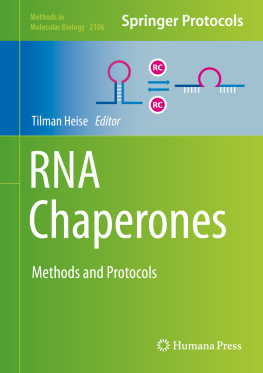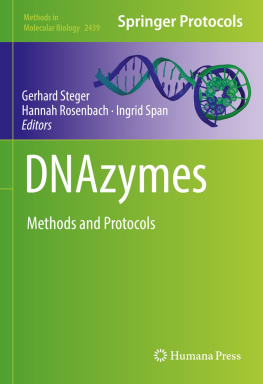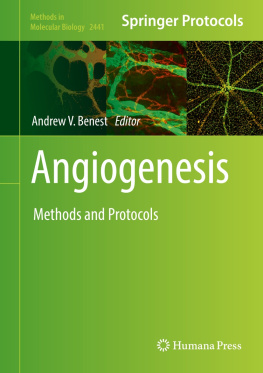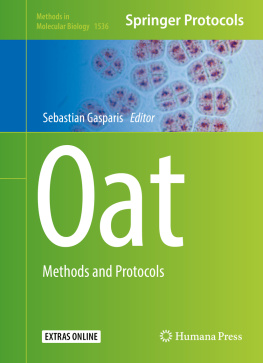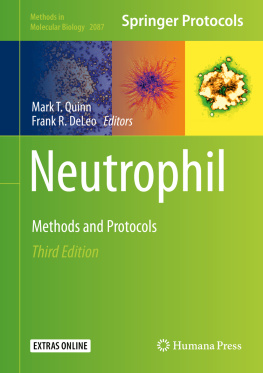Tilman Heise - RNA Chaperones: Methods and Protocols
Here you can read online Tilman Heise - RNA Chaperones: Methods and Protocols full text of the book (entire story) in english for free. Download pdf and epub, get meaning, cover and reviews about this ebook. year: 2020, publisher: Human, genre: Home and family. Description of the work, (preface) as well as reviews are available. Best literature library LitArk.com created for fans of good reading and offers a wide selection of genres:
Romance novel
Science fiction
Adventure
Detective
Science
History
Home and family
Prose
Art
Politics
Computer
Non-fiction
Religion
Business
Children
Humor
Choose a favorite category and find really read worthwhile books. Enjoy immersion in the world of imagination, feel the emotions of the characters or learn something new for yourself, make an fascinating discovery.
- Book:RNA Chaperones: Methods and Protocols
- Author:
- Publisher:Human
- Genre:
- Year:2020
- Rating:4 / 5
- Favourites:Add to favourites
- Your mark:
- 80
- 1
- 2
- 3
- 4
- 5
RNA Chaperones: Methods and Protocols: summary, description and annotation
We offer to read an annotation, description, summary or preface (depends on what the author of the book "RNA Chaperones: Methods and Protocols" wrote himself). If you haven't found the necessary information about the book — write in the comments, we will try to find it.
RNA Chaperones: Methods and Protocols — read online for free the complete book (whole text) full work
Below is the text of the book, divided by pages. System saving the place of the last page read, allows you to conveniently read the book "RNA Chaperones: Methods and Protocols" online for free, without having to search again every time where you left off. Put a bookmark, and you can go to the page where you finished reading at any time.
Font size:
Interval:
Bookmark:

For further volumes: http://www.springer.com/series/7651
For over 35 years, biological scientists have come to rely on the research protocols and methodologies in the critically acclaimedMethods in Molecular Biologyseries. The series was the first to introduce the step-by-step protocols approach that has become the standard in all biomedical protocol publishing. Each protocol is provided in readily-reproducible step-by-step fashion, opening with an introductory overview, a list of the materials and reagents needed to complete the experiment, and followed by a detailed procedure that is supported with a helpful notes section offering tips and tricks of the trade as well as troubleshooting advice. These hallmark features were introduced by series editor Dr. John Walker and constitute the key ingredient in each and every volume of theMethods in Molecular Biologyseries. Tested and trusted, comprehensive and reliable, all protocols from the series are indexed in PubMed.

This Humana imprint is published by the registered company Springer Science+Business Media, LLC, part of Springer Nature.
The registered company address is: 233 Spring Street, New York, NY 10013, U.S.A.
The RNA folding problem describes the circumstance that RNA molecules can fold into various secondary and tertiary structures and that only some of those structures are of functional relevance. Hence, the intrinsic nature of RNA to fold into nonfunctional structures implies that mechanisms exist to convert a nonfunctional to a functional RNA structure.
RNA might fold into helical regions; might form hairpins, bulges, and loops; and might establish three-dimensional contacts such as pseudoknots. The larger an RNA molecule, the more folding possibilities exist, leading to a compendium of coexisting and interchanging RNA conformations in solution. The discovery of small and long noncoding RNAs annealingin transto other RNA molecules requires activities facilitating strand annealing and strand separation steps. Software tools and methods exist to predict RNA structures and to confirm the predicted folding of RNA into a specific structure. However, in a cellular context, considering RNA modifications and the presence of RNA-binding proteins which both may significantly influence the RNA fold, the validation of predicted RNA structures is of tremendous importance.
The dynamics of RNA folding contribute to the regulation of various cellular processes including transcription, mRNA splicing, translation, mRNA decay, ribosome assembly, ribozyme activity, and viral replication. Hence, it is vital to understand in what way an RNA fold can be converted to an alternative fold, how an RNA hairpin structure can be formed or destabilized, or to what extent two single RNA molecules anneal or separate.
RNA is always associated with RNA-binding proteins (RBPs) forming ribonucleoprotein particle (RNPs). Some RBPs are RNA helicase destabilizing, for example, stable RNA hairpins under the consumption of ATP. However, the focus of this book are protocols to study RNA chaperones, a specific class of RBPs proposed to assist structural changes in RNA molecules. RNA chaperones are promoting strand annealing (matchmaker activity) or strand separation, thereby changing structural elements in a given RNA molecule without the consumption of ATP.
To assist RNA restructuring, an RNA chaperone has to bind the RNA, resolve the existing structure, and allow the formation of an alternative structure. This chaperoning from an energetically trapped RNA structure to an alternative structure requires activation energy. An RBP can bind RNA in a highly specific and tight way, or they are less specific and form weak interaction with the RNA. It is likely that a highly specific RBP selects for a specific RNA fold due to its specific sequence and structural characteristics required for specific interaction. RBPs with low sequence/structure specificity are likely to bind a variety of RNA folds.
RNA chaperones often contain intrinsic disorder regions. This observation led to a model of how RNA chaperones assist structural changes in RNA. It is assumed that upon binding of the RNA, the intrinsic disordered regions of the RNA chaperone are highly organized, allowing additional protein-RNA interactions to occur. During this process of RNA chaperone organization, an entropy transfer occurs, meaning that higher organization of the RNA chaperone (loss in entropy) leads to unfolding (increase in entropy) of the RNA. Upon RNA chaperoning, RNA chaperones are releasing the restructured RNA, raising the question of whether the released RNA and RBP fold again into alternative structures. In contrast to this transient RBP-RNA complex formation, it is also possible that a weak and low specific interaction leads to restructuring of the RNA, evoking a specific interaction and a tight RNP complex formation. In this model, an initial weak RBP-RNA interaction initiates the formation of a strong RBP-RNA interaction. Such a tight complex might be critical in order to keep the RNA sequence/structure stabilized and further provide a nucleation point for assembly of an even larger RNP.
Font size:
Interval:
Bookmark:
Similar books «RNA Chaperones: Methods and Protocols»
Look at similar books to RNA Chaperones: Methods and Protocols. We have selected literature similar in name and meaning in the hope of providing readers with more options to find new, interesting, not yet read works.
Discussion, reviews of the book RNA Chaperones: Methods and Protocols and just readers' own opinions. Leave your comments, write what you think about the work, its meaning or the main characters. Specify what exactly you liked and what you didn't like, and why you think so.

